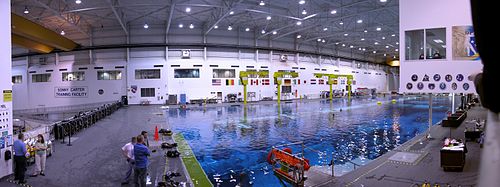Template:Infobox laboratory

Simulation control area
The Neutral Buoyancy Laboratory (NBL) is an astronaut training facility and neutral buoyancy pool operated by NASA and located at the Sonny Carter Training Facility, near the Johnson Space Center in Houston, Texas.[1] The NBL's main feature is a large indoor pool of water,[2] in which astronauts may perform simulated EVA tasks in preparation for upcoming missions. Trainees wear suits designed to provide neutral buoyancy to simulate the microgravity that astronauts would experience during spaceflight.
Pool features[]
The diving tank is 202 feet (Template:Convert/round m) in length, 102 feet (Template:Convert/round m) wide, and Template:Convert/LoffAoffDbSoff2 deep, and contains 6.2 million gallons (23.5 million litres) of water.[3][4] The NBL contains full-scale mock-ups of International Space Station (ISS) modules and payloads, as well as visiting vehicles such as the Japan Aerospace Exploration Agency (JAXA) HTV, the European Space Agency ATV, the SpaceX Dragon, and the Orbital Sciences Corporation Cygnus.[3] Previously there was also a mockup of the Space Shuttle payload bay, but since Space Shuttle retirement it has been removed.
History[]
In the late 1980s NASA began to consider replacing its previous neutral-buoyancy training facility, the Weightless Environment Training Facility (WETF). The WETF, located within Johnson Space Center, had been successfully used to train astronauts for numerous missions, but its pool was too small to hold useful mock-ups of space station components of the sorts intended for the mooted Space Station Freedom, or its successor, the International Space Station. NASA purchased the structure that now holds the NBL from McDonnell Douglas in the early 1990s and began refitting it as a neutral-buoyancy training center in 1995.[5]
Neutral-buoyancy training[]
During training exercises, neutral-buoyancy diving is used to simulate the weightlessness of space travel. To achieve this effect, suited astronauts or pieces of equipment are lowered into the pool using an overhead crane and then weighted in the water by support divers so that they experience minimal buoyant force and minimal rotational moment about their center of mass.[1] The suits worn by trainees in the NBL are down-rated from fully flight-rated EMU suits like those in use on the Space Shuttle and International Space Station. Divers breathe nitrox while working in the tank.[6][7]
Training challenges[]
One disadvantage of neutral-buoyancy diving as a simulation of microgravity is the significant amount of drag created by the water.[8] This makes it difficult to set an object in motion, and difficult to keep it in motion. It also makes it easier to keep the object stationary. This effect is the opposite of what is experienced in space, where it is easy to set an object in motion, but very difficult to keep it still. Generally, drag effects are minimized by doing tasks slowly in the water.
Another downside of neutral buoyancy simulation is that astronauts are not weightless within their suits, meaning that as divers tilt their suits they are pressed against whatever inside surface is facing down. This can be uncomfortable in certain orientations, such as heads-down. Thus, precise suit sizing is critical.
See also[]
- Neutral buoyancy pool
- Weightlessness
- Vomit Comet
References[]
- ↑ 1.0 1.1 Template:Cite journal
- ↑ "Behind the scenes training". NASA. May 30, 2003. http://spaceflight.nasa.gov/shuttle/support/training/nbl/facilities.html. Retrieved March 22, 2011.
- ↑ 3.0 3.1 Template:Cite journal
- ↑ "NBL Characteristics". About the NBL. NASA. June 23, 2005. http://dx12.jsc.nasa.gov/about/index.shtml.
- ↑ Template:Cite news
- ↑ Template:Cite journal
- ↑ Template:Cite journal
- ↑ Template:Cite journal
| ||||||||||||||||
Template:Coord
| This page uses Creative Commons Licensed content from Wikipedia (view authors). | 
|
